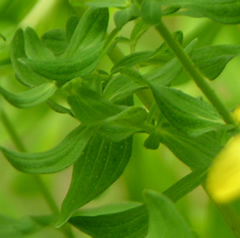Plant: in full, partial sun. Can tolerate most soils if the soil is moist. There will be more flowers if there is more sun, but the plant will grow in partial shade.
Flowers: yellow [tending towards orange] with five petals, May to August.
Harvest: flowering shoots in early summer and dry.
Uses: it attracts insects. Various dyes can be obtained and depending on the extraction, these may be yellow to brown [if extracted in water] or red [if infused in alcohol or oil.]
Medicinal Uses: is normally used to relieve anxiety and depression. It is also often used for incontinence in children. St. John's wort has anti-retroviral properties with no side effects. Some people use St. John's wort to reduce the effects of prescription medications. Externally, it is used as an ointment or poultice for ulcers, tumors, and nerve pain.
Taste: the sepals are bitter. The herb as a whole is bitter, astringent, as well as slightly sweet.
Warnings: Not to be used by pregnant women. Be aware of photosensitivity. If using St. John's wort, it may be wise to avoid prolonged exposure to the sun, especially if fair skinned.
Habitat Considerations: St. John's wort is found in Europe, Asia Minor, Asia, and North America. It grows wild in meadows. Animals should not graze on St. John's wort because it can cause photosensitization or miscarriage. In rare instances, it can cause death.
 Notes: the common name of the plant comes from the flowering around June 24, St. John's Day. Hypericum comes from the Greek for "above" and "picture" because the herb was placed over icons to ward off evil. The species name, "perforatum", refers to the oil glands on the leaves. If you hold the leaves up to the light, it looks like they are perforated, but the leaves do not actually have oils, just transparent reservoirs of essential oils and resin. Notes: the common name of the plant comes from the flowering around June 24, St. John's Day. Hypericum comes from the Greek for "above" and "picture" because the herb was placed over icons to ward off evil. The species name, "perforatum", refers to the oil glands on the leaves. If you hold the leaves up to the light, it looks like they are perforated, but the leaves do not actually have oils, just transparent reservoirs of essential oils and resin.
|
